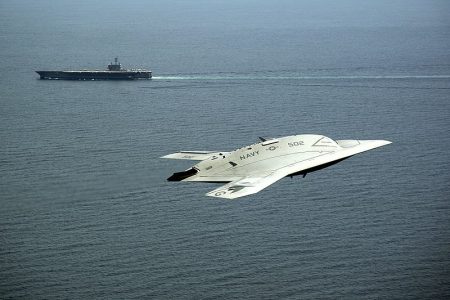August 6, 2018 – The United States, Russia, and China are in a new arms race to exploit the emerging disruptive technologies of the 21st century. The phrase “weaponizing of” precedes the words artificial intelligence (AI), automation, biology, lasers, outer space, and robotics these days in conversations about and by the military of these three countries.
The use of technology in the wars of the first two decades of this century is not considered the paradigm for anticipated future conflicts. That’s because these have been wars largely fought on the ground and in the air in response to international interventions, quelling of intranational uprisings and civil wars, and land grabs.
We are talking about the continuing Afghanistan conflict now some 17 years old, the Iraq war of 2003 and the post-war fallout leading to the rise of ISIS and its African offshoots, the continuing Israel-Palestine neverendum, Russia’s incursions into Crimea and Ukraine, as well as Georgia, and the ongoing instability in Korea. All of these are extensions of 20th-century conflicts fought largely with 20th-century technologies.
The rise of cyber warfare fought from desks in offices and back rooms is a phenomenon engendered by a global-wide communications revolution of the late 20th century, the Internet. Today this is defined as a war of electrons and AI with algorithms battling for strategic advantage while ensuring no breaches occur in military or domestic infrastructure and operations including politics and elections.
And then there is the insertion of the military into the fields of biomedical engineering and biomedicine with improvements to prosthetic limbs (a development fueled by battlefield ground war injuries to thousands of soldiers in Afghanistan and Iraq), development of exoskeletons to enhance soldier capability on the battlefield, brain implants connected to augmented reality, and DNA-altering technologies in pursuit of creating super-soldiers.
Back in March of last year, I wrote a posting entitled “The Battlefields of the Future: Robot Armies vs. Enhanced Humans.” I described the Mad Scientist Initiative, an alliance of the military, academics, and business, focused on future wars. Among Mad Scientist’s current key areas of interest are these three:
- Robotics, AI, and Autonomy aimed at future operational military environments with smart, connected and self-organizing command and weapon systems working closely with humans supporting all aspects of decision making in an operational theatre whether on land, sea, air or space.
- Bio-convergence and advanced computing where humans are network-connected through embedded and worn devices.
- Cyberwarfare to ensure human-AI assets are able to combat any new threat whether on the battlefield or in domestic space.
But the reach of the military into scientific discovery and technological invention is not limited to these areas. Consider the following:
- Genetic engineering tools like CRISPR can be weaponized to create synthetic biology, enhanced pathogens, or even altered gut bacteria that could be delivered by a chemical weapon to disable a human enemy force.
- Both Russia and the United States are building robots designed to fight on battlefields of the future with humans by their sides or autonomously.
- China is building laser weapons designed to blind oncoming enemies in the air while the Americans are working on a ray gun to take out the electronics of an oncoming vehicle.
- And Boeing, an American aerospace and defense contractor has patented a technology to act as a force field ionizing the atmosphere between itself and an oncoming missile or shell. Boeing isn’t alone in inventing what is similar to the shields of Star Trek science fiction. The United Kingdom’s Defence Science and Technology Laboratory recently went public with an announcement of a force field for tanks.
And none of these military technological advancements are about missiles and nuclear weapons which remain deterrent weapons with delivery and destructive force capable of wiping out civilization and life over much of the planet. Even in these areas, a rethink is underway to make nuclear weapons smaller with lower yields to make them more battlefield friendly to deliver precision blows to small sites rather than wipe out an entire city. And successors to today’s cruise missiles are in the works as well with hypersonic replacements capable of traveling up to Mach 5 (five times the speed of sound). Russia recently announced a hypersonic cruise missile that could evade any state-of-the-art weapon detection systems.
Finally, there is the militarizing outer space. The Soviet Union and its successor Russia, China, and the United States have all been sending aloft military payloads to spy on each other’s ground, sea and air forces. But the most recent call by the President of the United States to create a separate military branch called the Space Force is something entirely new. Donald Trump in his space policy announcement directed the Department of Defense to ensure “American dominance in space.” In a recent interview on CNN, U.S. Congressman Mike Rogers stated, “the future of war will be fought in space.”
Russia, China, and the United States haven’t been shy about developing kinetic, laser, radio jamming and robotic weapons designed to target Earth-orbiting satellites. China even demonstrated a kinetic weapon on one of their own satellites in the last few years. If all that gets developed are counter-space capabilities to knock out enemy observation and infrastructure satellites, this will not amount to a space war. The idea of a Space Force where human or AI-operated gunships could fire from space on satellite and Earth targets would be a major escalation. Let’s hope this is not the direction that spacefaring countries like Russia, China, and the United States today choose to go.
















